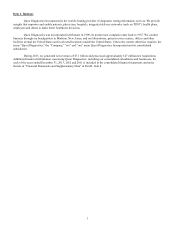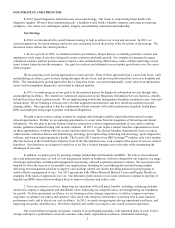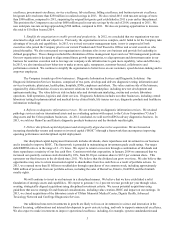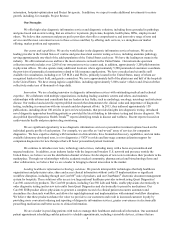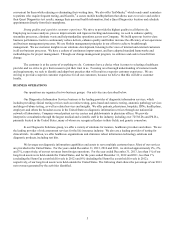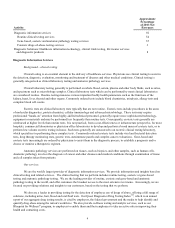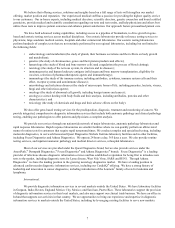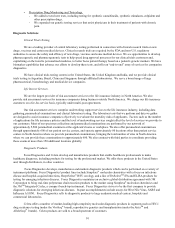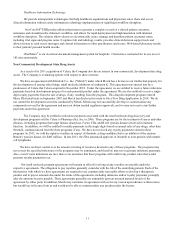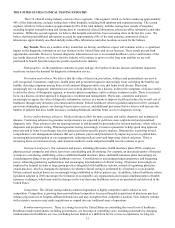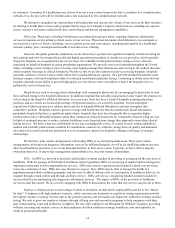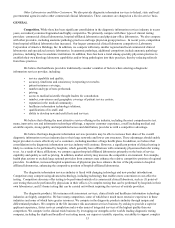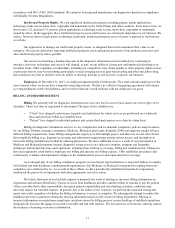Quest Diagnostics 2013 Annual Report Download - page 15
Download and view the complete annual report
Please find page 15 of the 2013 Quest Diagnostics annual report below. You can navigate through the pages in the report by either clicking on the pages listed below, or by using the keyword search tool below to find specific information within the annual report.11
Healthcare Information Technology.
We provide interoperable technologies that help healthcare organizations and physicians enter, share and access
clinical information without costly information technology implementation or significant workflow disruption.
Our Care360® EHR product allows physicians to generate a complete record of a clinical patient encounter,
automates and streamlines the clinician's workflow, and allows for rapid deployment and implementation with minimal
workflow disruption. The solution allows doctors to electronically create, manage and distribute patient encounter notes,
including vital signs and progress notes. It captures lab and radiology results, provides clinical decision support tools and
allows doctors to send secure messages and clinical information to other practitioners and secure, Web-based laboratory results
to their patients' personal health records.
ChartMaxx® is our electronic document management system for hospitals. Clients have contracted for its use at over
185 sites nationwide.
Non-Commercial, Development State Drug Assets
As a result of its 2011 acquisition of Celera, the Company also has an interest in non-commercial, development state drug
assets. The Company is evaluating options with respect to these interests.
We have an agreement with Merck & Co., Inc. ("Merck") under which Merck has a license to our intellectual property for
the development of, among other things, small molecule inhibitors of cathepsin K. This agreement was entered into by a
predecessor of Celera that Celera acquired in November 2001. Under the agreement, we are entitled to receive future milestone
payments based on development progress for each potential product under the agreement. We are also entitled to receive single
digit royalty payments from the sale of drugs, if any, resulting from the program. This drug development program entered
Phase III clinical trials in September 2007 and Merck has disclosed its intent to file a New Drug Application in 2014. We do
not control the development activities conducted by Merck. Merck may not successfully develop or commercialize any
compounds covered by the agreement and may not obtain needed regulatory approvals, and we may not receive any further
payments under this agreement.
The Company may be entitled to milestone payments associated with the small molecule drug discovery and
development programs sold by Celera to Pharmacyclics, Inc. in 2006. These programs are for the treatment of cancer and other
diseases, including programs that target histone deactylase, Factor VIIa, and B cell tyrosine kinases involved in immune
function. In addition, we will be entitled to royalty payments in the single digits based on annual sales of any drugs, other than
ibrutinib, commercialized from the three programs, if any. We have not received any royalty payments related to these
programs. In 2013, we sold the rights to royalties in respect of ibrutinib, a drug candidate that is an inhibitor of the enzyme
Bruton's tyrosine kinase, for $485 million. In late 2013, the FDA announced approval of ibrutinib to treat patients with mantle
cell lymphoma.
We have no direct control over the amount or timing of resources devoted to any of these programs. The programs may
never meet the specified milestones or the programs may be terminated, and therefore may never generate milestone payments.
Also, even if some milestones are met, there is no assurance that these programs will result in any product sales that would
generate royalty payments to us.
Our small molecule program agreements will remain in effect for as long as any royalties are payable under the
respective agreements. The obligation to pay royalties generally coincides with the life of the underlying patents. Each of the
third parties with which we have agreements are required to use commercially reasonable efforts to develop a therapeutic
product and to pay us amounts due under the terms of the agreements, including milestone and/or royalty payments, promptly
after the amounts become payable. These agreements generally are terminable upon an uncured material breach of the
agreement by either party. In addition, Merck may terminate its agreement with us for any reason upon advance written notice,
but would lose its license from us and would not be able to commercialize any product under the license.


